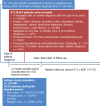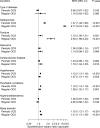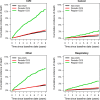Oral corticosteroid use, morbidity and mortality in asthma: A nationwide prospective cohort study in Sweden
- PMID: 31095758
- PMCID: PMC6899917
- DOI: 10.1111/all.13874
Oral corticosteroid use, morbidity and mortality in asthma: A nationwide prospective cohort study in Sweden
Erratum in
-
Corrigendum.Allergy. 2020 Aug;75(8):2148-2148. doi: 10.1111/all.14233. Allergy. 2020. PMID: 32716085 Free PMC article. No abstract available.
Abstract
Background: Patterns and determinants of long-term oral corticosteroid (OCS) use in asthma and related morbidity and mortality are not well-described. In a nationwide asthma cohort in Sweden, we evaluated the patterns and determinants of OCS use and risks of OCS-related morbidities and mortality.
Methods: Data for 217 993 asthma patients (aged ≥ 6 years) in secondary care were identified between 2007 and 2014 using Swedish national health registries. OCS use at baseline was categorized: regular users (≥5 mg/d/y; n = 3299; 1.5%); periodic users (>0 but <5 mg/d/y; n = 49 930; 22.9%); and nonusers (0 mg/d/y; n = 164 765; 75.6%). Relative risks of becoming a regular OCS user and for morbidity and mortality were analysed using multivariable Cox regression.
Results: At baseline, 24% of asthma patients had used OCS during the last year and 1.5% were regular users. Of those not using OCS at baseline, 26% collected at least one OCS prescription and 1.3% became regular OCS users for at least 1 year during the median follow-up of 5.3 years. Age at asthma diagnosis, increasing GINA severity and Charlson Comorbidity Index were associated with regular OCS use. Compared to periodic and non-OCS use, regular use was associated with increased incidence of OCS-related morbidities and greater all-cause mortality, adjusted HR 1.34 (95% CI 1.24-1.45).
Conclusions: Oral corticosteroids use is frequent for asthma patients, and many are regular users. Regular OCS use is associated with increased risk of morbidity and mortality. These findings indicate that there is a need of other treatment options for patients with severe asthma who are using regular OCS.
Keywords: asthma; corticosteroids; morbidity; mortality.
© 2019 The Authors Allergy Published by John Wiley & Sons Ltd.
Conflict of interest statement
PH and GT are employed by AstraZeneca. FW is employed at Statisticon for which AstraZeneca is a client. ME, BN and CJ report no conflict of interest relevant to this article.
Figures




References
-
- Global asthma report. [2018 20.11.2018]. http://globalasthmareport.org/Global%20Asthma%20Report%202018.pdf
-
- Batema ED, Hurd SS, Barnes PJ, et al., Global strategy for asthma management and prevention: GINA executive summary. Eur Respir J. 2018;31:143-178. - PubMed
-
- von Bülow A, Kriegbaum M, Backer V, Porsbjerg C. The prevalence of severe asthma and low asthma control among Danish adults. J Allergy Clin Immunol Pract. 2014;2(6):759‐767. - PubMed
-
- Hyland ME, Whalley B, Jones RC, Masoli M. A qualitative study of the impact of severe asthma and its treatment showing that treatment burden is neglected in existing asthma assessment scales. Qual Life Res. 2015;24(3):631‐639. - PubMed
Publication types
Grants and funding
LinkOut - more resources
Full Text Sources

